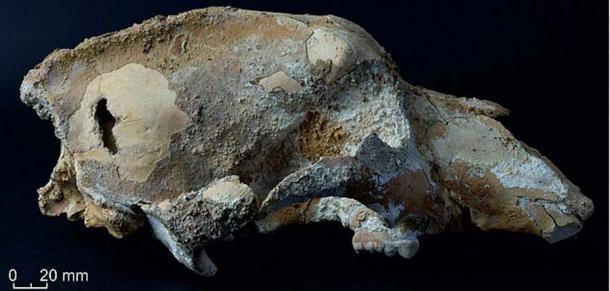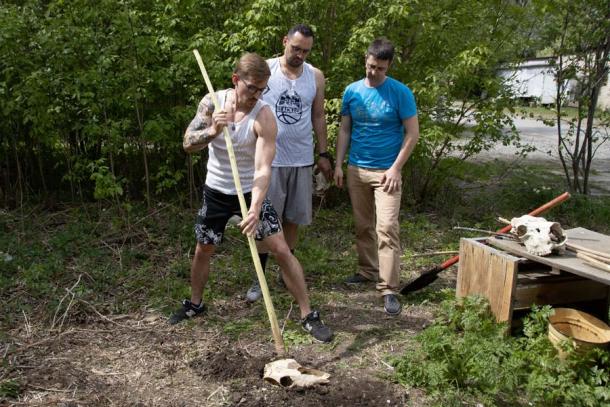IMPORTANT: First Evidence that Whites killed animals with spears 35,000 years ago!
(005875.811-:E-000062.43:N-AC:R-SU:C-30:V)
[This is fascinating. Given the location these would be our ancestors. Our ancestors occupied Europe 40,000 to 45,000 Years ago. The most plausible explanation is that Whites with spears killed this bear. Jan]
A Russian Ice Age cave bear skull was found with a small hole at the back of its head. This hole might have been caused by one of several methods, however, if it was a spear hole, which evidence suggests, then this is the earliest example of this animal being hunted by humans.
The small cave bear skull was from an animal that lived 35,000 years ago, based a tooth analysis. It was uncovered in Russia and the hole at the back of the skull suggests it was killed with a spear while it was hibernating. If this event happened the way scientists think it unfolded then the finding represents the earliest evidence of humans hunting this species of bear. However, spears are not the only thing that can make a hole in a skull.

Lateral view of the small cave bear skull (U. ex gr. savini-rossicus) from the Imanay Cave in eastern Russia. ( Bulletin of Archeology, Anthropology, and Ethnography )
Cave Bear Skull Hole: Accidental or Made By a Spear?
The Pleistocene cave bear lived in the faunas of Western Europe, the Russian Caucasus and the Ural Mountains . The particular bear in question weighed between 880 to 2,200 pounds (400 to 998 kilograms). A team of researchers from Ural Federal University uncovered this bear skull in the Imanay Cave, in the Bashkiria National Park, located at the southern end of the Ural Mountains.
- The Controversial Dashka Stone: 120-Million-Year-Old Map?
- 4000-Year-Old Ural Necropolis Reveals Migrant Horse Breeders Died Very, Very Young
According to a new study published in “ Vestnik Archeologii, Anthropologii I Ethnographii (Bulletin of Archeology, Anthropology, and Ethnography) ” the skull has a hole at the back that was made about 35,000 years ago, when the bear was between 9 and 10 years old.
However, Dr Dmitry Gimranov, a senior researcher of the laboratories at the Ural Branch of the Russian Academy of Sciences and Ural Federal University, said in a statement that while the hole in the animal’s skull might have been caused after death ritually by a spear, alternative explanations exist.
Earliest Evidence Of Human Small Cave Bear Hunters?
It was considered that the hole might have been caused naturally by a stone falling on the bear’s head while it was hibernating. However, the team also had to consider that the hole was perhaps caused by dripping water over thousands of years.
Dr Gimranov is quoted in the Daily Mail saying the idea that a falling rock or a constant water drip are both “highly unlikely.” In conclusion the professor believes that most likely the animal was killed by ancient people, and if so, this is “the earliest evidence of the animal being hunted by humans,” he said.
The last Ice Age , which sanded down mountains, created new rivers, and entirely changed the face of our planet, occurred during the Pleistocene period, between 2.8 million years ago and 11,700 years ago.
The Russian cave bear skull was one of over 10,000 animal remains dating to the Late Pleistocene that were excavated from in the Bashkiria National Park. The bones recovered from other animal species included red foxes , mammoths, cave lions and wooly rhinos .
Dr Gimranov and his team were able to date the bear skull by analyzing growth layers on its teeth and this also allowed them to determine the bear ’s age when it died (between 9 and 10). However, to determine whether the small cave bear had actually been speared in the head or not, the team of scientists first had to determine if the hole in its skull was made during its life or after the death of the animal.

Ural Federal University researchers “enacting” the spearing of the cave bear skull. ( Ural Federal University )
The Most Probable Cause Of Death: Death by Hunting Spear
Adding to the suspicions that the bear was probably speared to death while it hibernated is the fact a Pleistocene site occupied by humans is located close by. Dr Gimranov noted that these ancient humans “had such strength that they could pierce the bear skull with a spear at close range with relative ease.”
- Ancient nanostructures found in Ural mountains are out of place and time
- Children Helped Build Mysterious 6,000-year-old Moose Geoglyph in Russia
According to a report in Eureka Alert , Gimranov said “hunting for large mammals was essential for life support of ancient humans.” However, hunting for small cave bears “was not a specialty of the ancient hunters who left traces of their stay in the Imanay cave” added professor. And it is for this reason it might have been the case that the bear was ritually speared, rather than hunted.
Top image: This reconstructed cave bear skeleton, found in a Bavarian cave, is the same species as the one belonging to bear skull discovered in Russia. The Russian cave bear skull had a strange hole in it that appears to have been made with a spear while it was hibernating or ritually after it was dead, which is the challenging question for scientists.
Source: https://www.ancient-origins.net/news-history-archaeology/pleistocene-cave-bear-skull-0015429
Video: The Conspiracy to destroy Germany: How the Allies created WW2 for no reason
We take a look at a German documentary that is the BEST defence of Germany that Ive ever come across. This is from a German General of modern times who analysed the causes of WW2. In here you will see things youve never heard of before.
Video: Zimbabwe: Chinese & Black Email spying, Assassination & Mass Graves
I chat to Johnny Rodrigues again who is now in Portugal having fled Zimbabwe in recent years because of threats to the life of him and his family. He was a Selous Scout in Rhodesia.
Get a Free PDF Book: White Power (1967) by George Lincoln Rockwell
This is the original book written by the late, great George Lincoln Rockwell, the US Navy Pilot who founded the American NAZI Party.Rockwell was the most determined White American who lived in modern times. He was patriotic to America and totally patriotic to the White Race. He supported Apartheid South Africa and Rhodesia. The Jews sent snipers to kill him and on the 2nd attempt they killed him.

